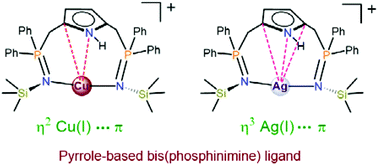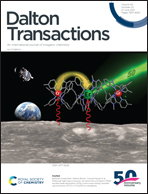Synthesis, structural characterization, and bonding analysis of two-coordinate copper(i) and silver(i) complexes of pyrrole-based bis(phosphinimine): new metal–pyrrole ring π-interactions†
Abstract
The reaction between 2,5-bis(diphenylphosphinomethyl)pyrrole and Me3SiN3 gave the new pyrrole-based bis(phosphinimine) L1H in an excellent yield. L1H reacts with [CuCl(COD)]2, AgBF4, or AgOTf to give the corresponding two-coordinate mononuclear ionic complex formulated as [M{(L1H)-κ2N,N}]+[X]− where M = Cu and Ag; X = [CuCl2], BF4 or OTf. Their single crystal X-ray diffraction studies confirmed the two-coordinate geometry formed by the chelate bonding mode of L1H. These 10-membered metalacycles exhibit planar chirality and were also characterized by spectroscopic methods. In addition, in all three structures, there exists a hitherto unknown π-interaction between the pyrrole ring atoms and metal, represented as η2-(Cα–N) in the copper(I) complex, and η3-(Cα–N–Cα′) in the silver(I) complexes. These weak interactions were supported by DFT calculations in terms of their electron densities, non-covalent interaction plots and the decrease in the aromaticity of the pyrrole ring.



 Please wait while we load your content...
Please wait while we load your content...